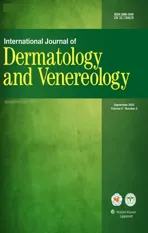Annulare With Tuberculosis and Cutis Laxa:A Rare Case Report
2023-06-07YiFeiWangYiGengXiuLianXu
Yi-Fei Wang, Yi Geng, Xiu-Lian Xu*
Department of Pathology, Hospital for Skin Diseases (Institute of Dermatology), Chinese Academy of Medical Sciences and Peking Union Medical College, Nanjing, Jiangsu 210042, China.
Abstract
Keywords: case report, cutis laxa, interstitial granuloma annulare
Introduction
Granuloma annulare (GA) is a benign, noninfectious granulomatous disorder of unknown etiology, characterized by an annular arrangement of erythematous small nodules and plaques, classically localized on dorsal surfaces of the hands and feet.Several clinical variants of GA have been described, including generalized GA, limited GA, subcutaneous GA, and perforating GA.1GA shows palisading granulomas with a central zone of necrobiotic collagen and mucin deposition surrounded by a palisade of histiocytes.GA has been associated with a variety of comorbidities,including diabetes mellitus, thyroid disorders, dyslipidemia,underlying malignancies, and tuberculosis.Here, we report a case of a 24-year-old man with giant-type generalized GA and tuberculosis that showed a large area of annular lesion combined with cutis laxa, which is rare.
Case report
A 24-year-old man waspresented with skin annular lesions on the trunk and extremities without subjective symptoms for three years.The annular lesions first arose in the trunk that slowly progressed to most parts of the body and cutis laxa-like lesions appeared on the left inguinal region with inguinal hernia two years ago.At the same time, the patient was diagnosed with pulmonary tuberculosis due to the hemoptysis for two years and the sputum culture for tuberculosis bacillus was positive.He was treated with triple anti-tuberculosis drugs regularly.Partial remission of the skin lesions was noted since then.The patient denied any personal or family history of cutaneous or internal malignancies except tuberculosis and the systemic examination was unremarkable.Physical examination revealed numerous well-defined flesh-color annular lesions on the trunk varying from several millimeters to several decimeters in diameter (Fig.1A and 1B).The lesions had elevated borders with slack centers.Most of them in the waist and back fused into giant multi-annular configuration.The skin of the groin parts was apparent slack and pendulous.There are small sporadic annular lesions over trunk and extremities.Rest of the general and systemic examinations was within normal limits.There is no thickening bundle of nerves and neurological symptoms.Routine blood and biochemical tests did not show any abnormal findings.Chest X-ray and computed tomography scan revealed post-inflammatory fibrosis in the right lung, indicating old pulmonary tuberculosis.T-cell receptor gene rearrangement revealed polyclonal gene rearrangement.Pathological examination of two biopsy specimens taken from lower abdomen and back showed similar histological changes in the interstitial pattern of GA.The epidermis was normal.The histiocytes and lymphocytes scattered between and around collagen bundles and blood vessels in the papillary and mid- dermis(Fig.1C and 1D).Immunochemistry revealed that the cells were positive for CD3, CD4, CD45R0, CD68, and CD2.LCA was diffusely positive, whereas Ki67 was 5%positive.Elastic fiber stain showed that the elastic fibers in dermis decreased significantly and part of them eliminated.Fragments of elastic fibers were engulfed within the multinucleated giant cell.Alcian blue stain revealed increased mucin deposition.
A final diagnosis of giant-type generalized GA with cutis laxa was made.Due to the tuberculosis, we didn’t do any special handling to the patient.After one year of follow-up, the patient now has recovered from tuberculosis and the tuberculin test is positive.He has stopped taking anti-tuberculosis medicine and no further progress of lesions has been found.The patient gave his agreement for the publication of his case.
Discussion
The etiology of generalized GA remains unknown and several systemic associations have been proposed, including chronic conditions, infectious diseases, minor traumas, and various malignancies.Some experts considered that tuberculosis was a possible etiologic factor in GA because of the coincidental occurrence, granulomatous histologic features, and positive tuberculin skin tests.Bacillus Calmette-Guérin vaccination as a precipitating factor have been reported several times.2However, some also recognized that many GA were unrelated to tuberculosis, but a phenotypic clinicopathological reaction to multiple etiologic agents and various forms of therapy was found.3In fact, some cases of GA with chronic pulmonary tuberculosis responding to a specific anti-tuberculosis therapy were reported.3Resolution may be related not only to the antimicrobial effects of the anti-tubercular drugs but also to an immunological stimulation, especially of rifampin, on cellular immune response.3In our case, the patient himself feel apparently relief from lesions after anti-tuberculosis treatment and stop recovery since stopping taking the medicine.Furthermore, it is worth noting that tuberculids, generalized exanthems in the skin of tuberculous patients possibly resulting from hypersensitivity reactions to the tubercle bacillus, may mimic GA.2
Histologically, a palisading or interstitial pattern of granulomatous inflammation attached mucin can represent the main pathological changes in all subtypes of GA, the latter one being more common but different to discern.The interstitial pattern is characterized by collections of histiocytes scattered around or between collagen bundles and blood vessels in the superficial and mid-dermis.The histopathological findings of our patient were consistent with interstitial-type GA.The differential diagnosis of interstitial-type GA involved necrobiosis lipoidica, actinic granuloma, interstitial granulomatous dermatitis, interstitial granulomatous drug reaction, and interstitial granuloma fungoid.Furthermore, our patient also showed extremely characteristic slack skin in posterior lumbar and groin, which was deemed to be related to reduction and destruction of elastic fibers.Based on the clinical and histological features, it is not hard to diagnose generalized GA.
The treatment of generalized GA includes topical,systemic, and phototherapy options.The size and localization of lesions influence the choice of treatment as well as the related diseases.Topical glucocorticosteroids can be proposed as first-line therapy.If available to patients, phototherapy, including PUVA or UVA1, may be tried as an assistant.If treatment with topical corticosteroids or phototherapy is impractical or ineffective, systemic treatment should be taken instead, such as hydroxychloroquine, isotretinoin, dapsone, or TNFalpha inhibitors.
No treatment given to the patient is the main limitation of this case.To the best of our knowledge, there have been no previous reports in the literature of generalized interstitial GA with tuberculosis and cutis laxa.It is important for clinicians to be aware of the possibility of this occurrence.
